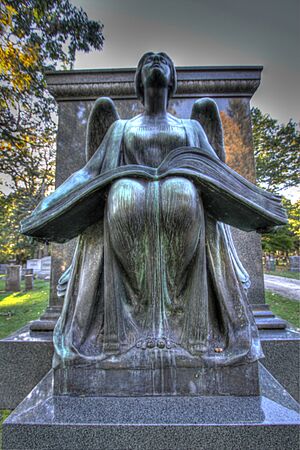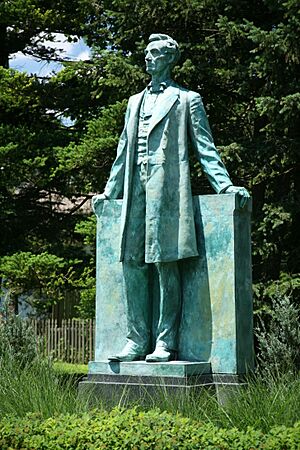Lorado Taft facts for kids
Quick facts for kids
Lorado Taft
|
|
|---|---|
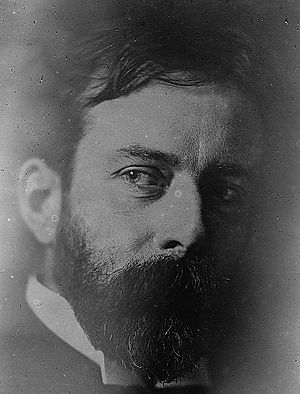 |
|
| Born | April 29, 1860 |
| Died | October 30, 1936 (aged 76) Chicago, Illinois
|
| Nationality | American |
| Known for | Sculpture |
Lorado Zadok Taft (born April 29, 1860, in Elmwood, Illinois – died October 30, 1936, in Chicago) was an important American sculptor, writer, and teacher. He wrote The History of American Sculpture in 1903. This was the first book to cover the topic and was used as a main reference for many years. He is also known for helping women become recognized sculptors.
Lorado Taft was the father of U.S. Representative Emily Taft Douglas. Her husband, U.S. Senator Paul Douglas, was his son-in-law. He was also a distant relative of U.S. President William Howard Taft.
Contents
Early Life and Education

Lorado Taft was born in Elmwood, Illinois. His father, Don Carlos Taft, was a geology professor at the Illinois Industrial University. This university is now known as the University of Illinois at Urbana-Champaign. Lorado spent much of his childhood near the university campus in Champaign, Illinois.
He was taught at home by his parents. Later, he earned his bachelor's degree in 1879 and his master's degree in 1880 from Illinois Industrial University.
After finishing his studies in Illinois, Taft went to Paris, France, to learn more about sculpture. From 1880 to 1883, he studied at the École nationale supérieure des Beaux-Arts. He was a very good student there and showed his art twice at the famous Paris Salon.
Career as a Sculptor and Teacher
When Taft returned to the United States in 1886, he settled in Chicago. He taught at The School of the Art Institute of Chicago until 1929. He taught his students how to work with clay and plaster. He also taught them how to carve marble. Taft also gave lectures at the University of Chicago and the University of Illinois.
In 1892, Chicago was getting ready for the World's Columbian Exposition of 1893. The main architect, Daniel Burnham, was worried that the sculptures for the buildings might not be ready in time. Taft asked if he could hire some of his female students to help. At that time, it was not common for women to work as sculptors.
Burnham agreed, saying, "Hire anyone, even white rabbits, if they'll do the work." This led to a group of talented female sculptors known as "the White Rabbits." This group included artists like Enid Yandell, Carol Brooks MacNeil, and Bessie Potter Vonnoh. Taft is remembered for helping women sculptors gain recognition.
Taft also gave many lectures across the country. His talks made him well-known to a wide audience. He often spoke about sculpture and art.
Writing and Art Associations
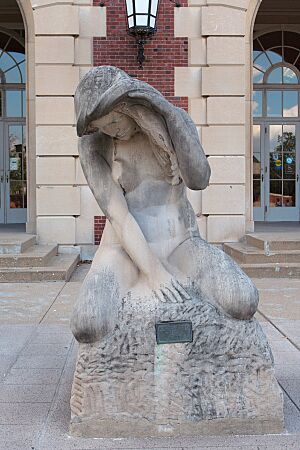
Lorado Taft was also known for his writing. In 1903, he published The History of American Sculpture. This was the first book to survey American sculpture. It remained the main reference book on the subject for many years. In 1921, he published Modern Tendencies in Sculpture. This book was a collection of his lectures. It gave a unique look at how European sculpture was developing.
Taft was a founding member of the Eagle's Nest Art Colony in Oregon, Illinois, in 1898. He designed the Columbus Fountain in Washington, D.C., with Daniel Burnham. Taft was a member of important art groups. These included the National Academy of Design and the American Academy of Arts and Letters. He also led the National Sculpture Society in the 1920s.
He stayed connected to his old university, the University of Illinois at Urbana-Champaign. In 1929, he dedicated his sculpture Alma Mater on the university campus. Taft imagined Alma Mater as a kind and grand woman. She is about 14 feet (4.3 m) tall. She steps forward with open arms, welcoming her students. Two figures behind her represent "Learning and Labor," the university's motto.
Later Years and Legacy
Lorado Taft received many awards and honorary degrees. He continued to work until the end of his life. The week before he passed away, he attended a ceremony for his sculpture in Quincy, Illinois. This sculpture celebrated the Lincoln–Douglas debates. He died in his home studio in Chicago on October 30, 1936.
Taft is perhaps best remembered for his many large fountains. The University of Illinois Archives has many photos of his important works. These include pictures of his sculptures being built.

One of his most famous works is the Fountain of Time. It was unveiled in Chicago in 1922 after more than ten years of work. The fountain shows a cloaked figure of Time watching people pass by. This idea came from a poem by Austin Dobson.
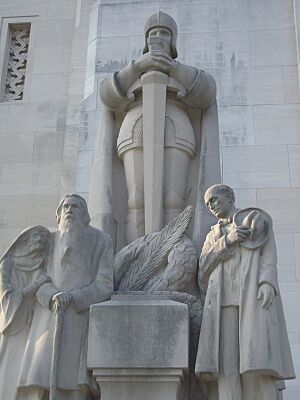
His last major project was two groups of sculptures for the entrance of the Louisiana State Capitol Building. These were finished in 1932.
He started a huge work called the Fountain of Creation. He planned for it to be at the other end of Chicago's Midway, opposite the Fountain of Time. He did not finish this work. Parts of it were given to the University of Illinois at Urbana-Champaign. They are now at the university library.
In 1965, his Chicago studio was named a National Historic Landmark. It is known as Lorado Taft Midway Studios.
Selected Sculptures
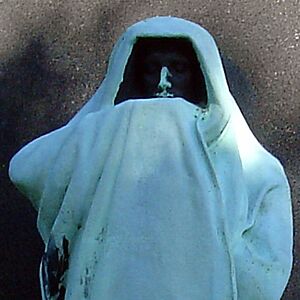
- LaFayette Fountain, Lafayette, Indiana, 1887
- Schuyler Colfax, Indianapolis, Indiana, 1887
- Statue of George Washington, Seattle, Washington, 1905–1909
- Eternal Silence, Chicago, Illinois, 1909
- Chief Paduke Statue, Paducah, Kentucky, 1909
- Black Hawk Statue Monument, Oregon, Illinois, 1911
- The Solitude of the Soul, Chicago, Illinois, 1911–1914
- Columbus Fountain, Washington, D.C., 1912
- Fountain of the Great Lakes, Chicago, Illinois, 1913
- Seated Woman With Children, Chicago, Illinois, 1915
- Thatcher Memorial Fountain, Denver, Colorado, 1918
- Two Boys with Dolphins Fountain, Oregon, Illinois, ca. 1920
- Fountain of Time, Chicago, Illinois, 1922
- Lincoln the Lawyer, Urbana, Illinois, 1927
- Alma Mater, University of Illinois at Urbana-Champaign, 1929
- The Crusader, Chicago, Illinois, 1931
- Two Groups: The Pioneers and The Patriots, Louisiana State Capitol, Baton Rouge, Louisiana, 1932
- Bas-relief of Lincoln – Douglas Debate, Quincy, Illinois, 1936
- Heald Square Monument, Chicago, Illinois, 1936–1941 (finished by others after his death)
War Memorials
- 4th Michigan Infantry Monument, Gettysburg Battlefield, Pennsylvania, 1889
- General Ulysses S. Grant Monument, Fort Leavenworth, Kansas, 1889
- Student Veteran Memorial, Hillsdale College, Hillsdale, Michigan, 1895
- Defense of the Flag, Jackson, Michigan, 1904
- The Soldiers' Monument, Oregon, Illinois, 1916
Images for kids
-
LaFayette Fountain (1887), Lafayette, Indiana
-
4th Michigan Infantry Monument (1889), Gettysburg Battlefield, Pennsylvania
-
Fountain of the Great Lakes (1907–1913), Chicago, Illinois
-
Black Hawk Statue (1908–1911), Oregon, Illinois
-
Columbus Fountain (1912), Washington, D.C.
-
The Soldiers' Monument (1916), Oregon, Illinois
-
Taft's self-portrait on the Fountain of Time (1922), Chicago, Illinois
-
Alma Mater (1929), University of Illinois at Urbana-Champaign
-
The Crusader (1931), Chicago, Illinois
Students and Assistants
Lorado Taft was a teacher and mentor to many sculptors during his career. Some of his students and assistants included:
- Enrique Alférez
- Jean Pond Miner Coburn
- Alice Cooper
- Leonard Crunelle
- Ulric Ellerhusen
- Paul Fjelde
- Sherry Edmundson Fry
- Waylande Gregory
- Carl Augustus Heber
- Frederick Hibbard
- Mary Lawrence
- Evelyn Beatrice Longman
- Frances Loring
- Carol Brooks MacNeil
- Helen Farnsworth Mears
- Charles Mulligan
- William Clark Noble
- C. Adrian Pillars
- Trygve Rovelstad
- Belle Kinney Scholz
- Janet Scudder
- Clara Sorensen
- John Storrs
- Charles Umlauf
- Bessie Potter Vonnoh
- Nellie Walker
- Julia Bracken Wendt
- Florence Wyle
- Enid Yandell
See also
 In Spanish: Lorado Taft para niños
In Spanish: Lorado Taft para niños


